AUTOSAR research: CP + AP integration, ecosystem construction, and localization will be the key directions.
AUTOSAR standard technology keeps upgrading, and the willingness to build open cooperation gets ever stronger.
The trend for the boom in intelligent vehicle basic software brings new development opportunities to AUTOSAR. In recent years, new AUTOSAR standards have been continuously introduced to adapt to the fast-growing automotive standard software market.
In December 2022, AUTOSAR delivered its latest release R22-11. Compared with the previous releases, the new standard proposed the cross-platform concept for the first time. Moreover, the AUTOSAR Classic Platform (AUTOSAR CP) adds V2X and DDS communication support for China; the AUTOSAR Adaptive Platform (AUTOSAR AP) offers additions or improvements in CAN, firewall, service-oriented vehicle diagnosis and other aspects. In the AUTOSAR AP architecture, compared with R20-11, the releases R21-11 and R22-11 remove ara:rest cluster and add ara:idsm and ara:fw clusters.
As the releases like AUTOSAR R20-11, R21-11 and R22-11 are published, the AUTOSAR AP specification is becoming mature. Some basic functions of the AP platform have been mature enough to be marketed, and the relevant software platforms compatible with the AUTOSAR AP, especially autonomous driving-related products, have been rolled out one after another. The first-generation AP-based vehicle models have come into the market, and the launch of more models equipped with the platform will also follow up.
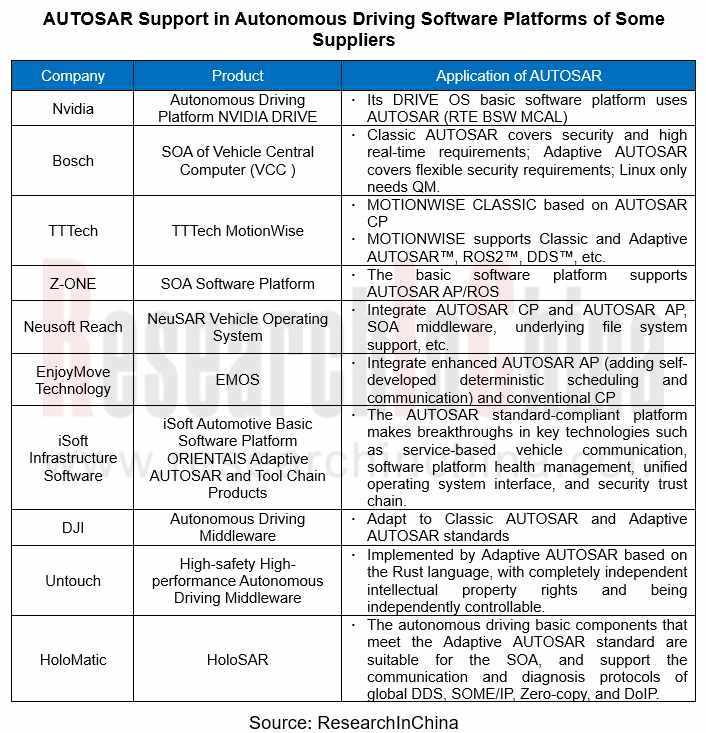
The future automotive industry will be a fully open ecosystem built by third-party collaborative organizations. This is also AUTOSAR’s future vision and important direction. As an alliance, AUTOSAR is making continuous efforts on cooperation with third parties. For example, in terms of Vehicle API for vehicle-cloud cooperation, AUTOSAR often partners with COVESA; as concerns data exchange formats, it teams up with ASAM; it cooperates with KHRONOS in hardware acceleration and image acceleration.
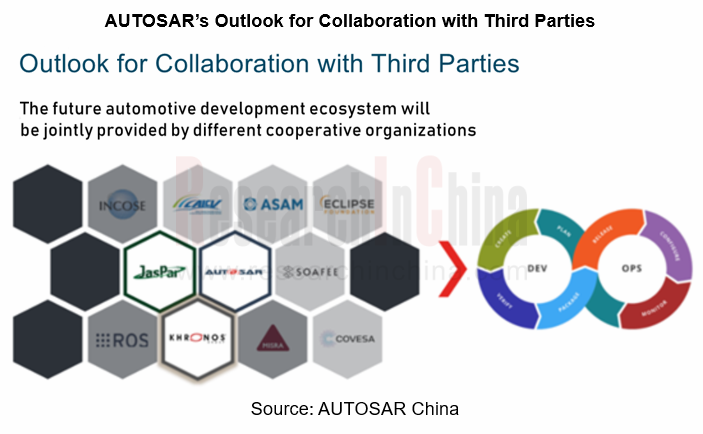
Following the development trend of E/E architecture, much more AUTOSAR CP+AP integrated products tend to be supplied.
Vehicle domain controller and vehicle central computer are developing by leaps and bounds, which is accompanied by the gradual evolution of vehicle E/E architecture towards centralized integration. For new-generation powerful processors, basic software of the two is required to pack both AUTOSAR AP and AUTOSAR CP to meet the requirements of the corresponding security domain and high-performance computing domain. The AUTOSAR CP+AP integrated supply becomes a major trend. While meeting technical performance requirements, it can greatly shorten the development cycle of software applications and reduce costs to achieve rapid iterations. In recent years, major suppliers have raced to launch their integrated solutions.
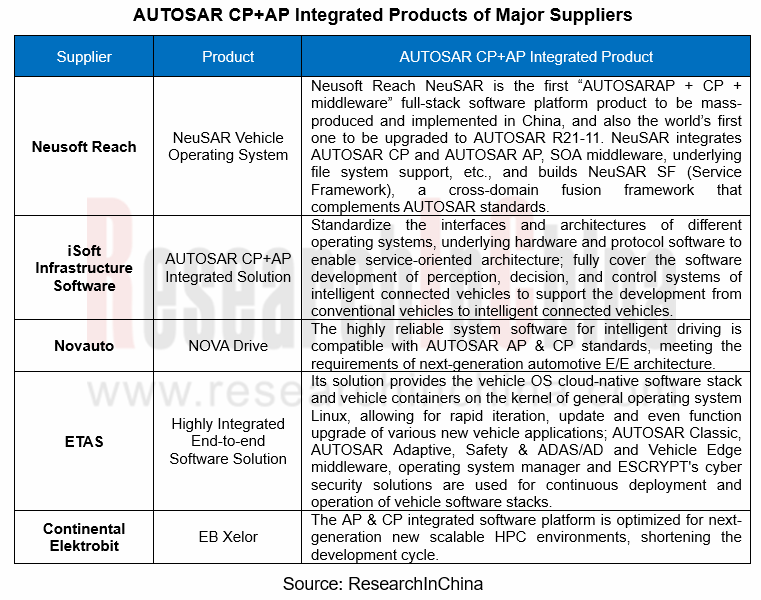
In April 2022, iSoft Infrastructure Software introduced its AUTOSAR CP+AP integrated solution. With features of hard real-time performance, high security, and low energy consumption, the solution meets automotive requirements, supports heterogeneous computing, and builds software system architecture that can be managed flexibly, enabling dynamic communication connection and deployment of applications. It also supports SOME/IP, DDS and other protocols, and can be used in intelligent driving, autonomous driving and Internet of Vehicles, covering such application scenarios as ADAS, intelligent cockpit, T-BOX, and domain controller.
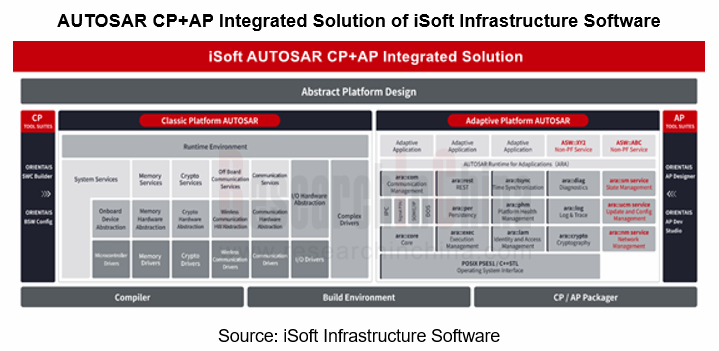
In addition, in the trend for AP+CP integrated supply, the architecture and methodology of the two are tending to integrated, which has started from the release AUTOSAR R21-11. Before R20-11, the architecture and methodology of AP and CP were separated. In the latest release R22-11, the concept of cross-platform is just proposed for the first time.
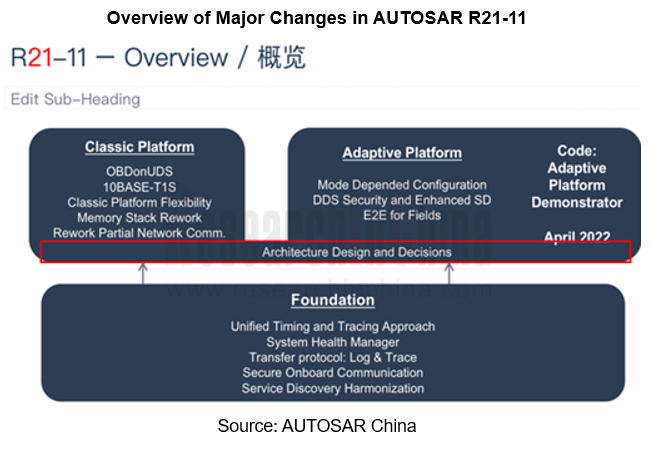
Chinese suppliers are working hard to deploy, and the localization of AUTOSAR in China is accelerating.
In the context of increasingly high requirements for vehicle development speed and function iteration, conventional software products and software development modes no longer fully adapt to the current market. In the face of the fast-paced intelligent vehicle market, suppliers, especially Chinese local suppliers, make an active response and keep launching new marketable products, answering the needs of customers for rapid iteration.
Neusoft Reach joined AUTOSAR in 2017 as a Premium Member. In December 2022, Neusoft Reach announced a new release of basic software - NeuSAR 4.0. As a new automotive software application development framework, NeuSAR 4.0 provides AUTOSAR standard-compliant components, including Classic AUTOSAR - NeuSAR cCore and Adaptive AUTOSAR - NeuSAR aCore. In this upgrade, both cCore and aCore are iterated to the release AUTOSAR R21-11.
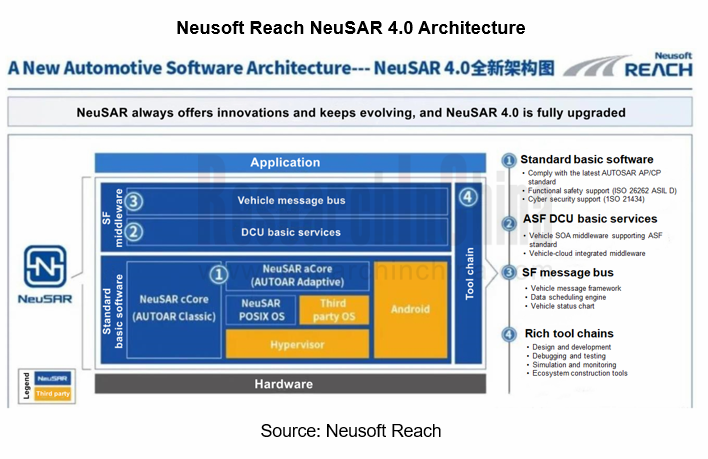
NeuSAR 4.0 not only still offers improvements in AUTOSAR, but also introduces a new automotive software application development framework for the cross-domain integration stage and upgrades the NeuSAR SF (Service Framework) and NeuSAR DevKit tool chain. It moves the development view from the domain controller level to the full vehicle level to solve the problem in software deployment for multi-core heterogeneous domain controllers, and also releases NeuSAR DS (Domain System) for prototype development platforms that integrates the latest AUTOSAR components and SF middleware.
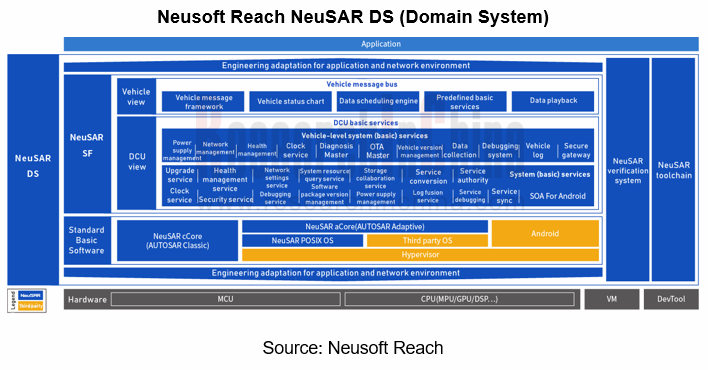
In recent years, in the background of the boom of intelligent vehicles in China and the increasing number of Chinese partners, AUTOSAR has valued the Chinese market more highly. Based on the original AUTOSAR User Group in China, in April 2022, AUTOSAR established the AUTOSAR China Hub, the third regional center outside of Japan and the US, aiming to enhance services and support for Chinese partners and carry out a range of AUTOSAR-related training or popularization activities.
Meanwhile, in 2022, the latest release AUTOSAR R22-11 added the new feature of "V2X Support for China" to the CP to further support China’s V2X technical standards. It is known that this feature is jointly developed by Huawei, Neusoft Reach, Bosch, BMW, Volkswagen Audi, Continental and HingeTech among others.
Based on the AUTOSAR architecture standards, China established the China Automotive Basic Software Ecosystem Committee (AUTOSEMO), with the aim of coordinating and organizing members to introduce a range of basic software standards and specifications, for example, providing white papers on the development of automotive basic software, ASF technical specifications, and vehicle-cloud integration technical specifications. Wherein, in the white papers on the development of automotive basic software, the basic software development platform is built on AUTOSAR AP and AUTOSAR CP; the ASF is an expansion of general basic software, and also expands the service management framework of AUTOSAR, facilitating localization of AUTOSAR in China.
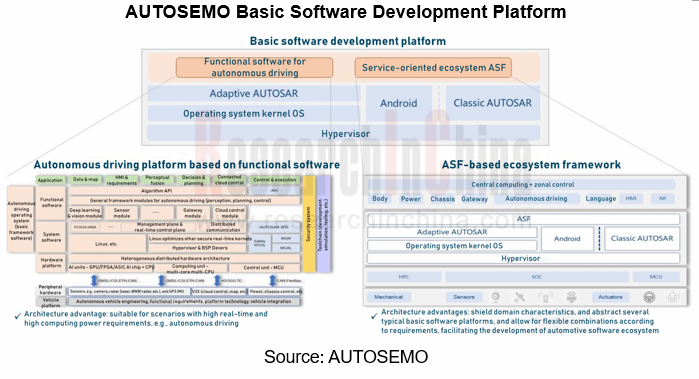
Software-defined Vehicle Research Report, 2023-2024 - Industry Panorama and Strategy
1. How to build intelligent driving software-defined vehicle (SDV) architecture?
The autonomous driving intelligent platform can be roughly divided into four parts from the bottom up: hardware platf...
Automotive DMS/OMS (Driver/Occupant Monitoring System) Research Report, 2023-2024
In-cabin Monitoring study: installation rate increases by 81.3% in first ten months of 2023, what are the driving factors?
ResearchInChina released "Automotive DMS/OMS (Driver/Occupant Monitoring Sys...
Automotive Functional Safety and Safety Of The Intended Functionality (SOTIF) Research Report, 2024
As intelligent connected vehicles boom, the change in automotive EEA has been accelerated, and the risks caused by electronic and electrical failures have become ever higher. As a result, functional s...
Autonomous Driving Map Industry Report,2024
As the supervision of HD map qualifications tightens, issues such as map collection cost, update frequency, and coverage stand out. Amid the boom of urban NOA, the "lightweight map" intelligent drivin...
Automotive Vision Industry Research Report, 2023
From January to September 2023, 48.172 million cameras were installed in new cars in China, a like-on-like jump of 34.1%, including:
9.209 million front view cameras, up 33.0%; 3.875 million side vi...
Automotive Voice Industry Report, 2023-2024
The automotive voice interaction market is characterized by the following:
1. In OEM market, 46 brands install automotive voice as a standard configuration in 2023.
From 2019 to the first nine month...
Two-wheeler Intelligence and Industry Chain Research Report, 2023
In recent years, two-wheelers have headed in the direction of intelligent connection and intelligent driving, which has been accompanied by consumption upgrade, and mature applications of big data, ar...
Commercial Vehicle Telematics Industry Report, 2023-2024
The market tends to be more concentrated in leading companies in terms of hardware.
The commercial vehicle telematics industry chain covers several key links such as OEMs, operators, terminal device ...
Automotive Camera Tier2 Suppliers Research Report, 2023
1. Automotive lens companies: "camera module segment + emerging suppliers" facilitates the rise of Chinese products.
In 2023, automotive lens companies still maintain a three-echelon pattern. The fir...
China Passenger Car Navigate on Autopilot (NOA) Industry Report, 2023
Intelligent driving is evolving from L2 to L2+ and L2++, and Navigate on Autopilot (NOA) has become a layout focus in the industry. How is NOA advancing at present? What are hotspots in the market? Wh...
Automotive Telematics Service Providers (TSP) and Application Services Research Report, 2023-2024
From January to September 2023, the penetration of telematics in passenger cars in China hit 77.6%, up 12.8 percentage points from the prior-year period. The rising penetration of telematics provides ...
Passenger Car Intelligent Chassis and Chassis Domain Controller Research Report, 2023
Passenger Car Intelligent Chassis and Chassis Domain Controller Research Report, 2023, released by ResearchInChina combs through three integration trends of brake-by-wire, steer-by-wire, and active su...
Automotive Smart Cockpit Design Trend Report, 2023
As the most intuitive window to experience automotive intelligent technology, intelligent cockpit is steadily moving towards the deep end of “intelligence”, and automakers have worked to deploy intell...
China Automotive Multimodal Interaction Development Research Report, 2023
China Automotive Multimodal Interaction Development Research Report, 2023 released by ResearchInChina combs through the interaction modes of mainstream cockpits, the application of interaction modes i...
Automotive Smart Surface Research Report, 2023
Market status: vehicle models with smart surfaces boom in 2023
From 2018 to 2023, there were an increasing number of models equipped with smart surfaces, up to 52,000 units in 2022 and 256,000 units ...
Passenger Car Intelligent Steering Industry Report, 2023
Passenger Car Intelligent Steering Industry Report, 2023 released by ResearchInChina combs through and studies the status quo of passenger car intelligent steering and the product layout of OEMs, supp...
Automotive High-precision Positioning Research Report, 2023-2024
Autonomous driving is rapidly advancing from highway NOA to urban NOA, and poses ever higher technical requirements for high-precision positioning, highlighting the following:
1. Higher accuracy: urb...
New Energy Vehicle Thermal Management System Research Report, 2023
Thermal management system research: the mass production of CO? heat pumps, integrated controllers and other innovative products accelerates
Thermal management of new energy vehicles coordinates the c...